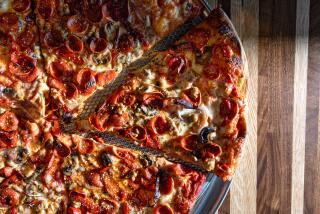Ending the Long Search for Suet Beef
- Share via
Question: “I enjoy your column very much, but sometimes I think you live more in the past than I do. You recommend adding beef suet to beef when grinding, and you call for beef suet in your Mom’s mincemeat recipe. Where, pray tell, do you find beef suet? Most butchers don’t even know what it is. And have you tried to get any marrow bones lately? I love poached marrow on toast but haven’t been able to find marrow bones for years. What’s happened?”
Answer: Times have changed in the meat business. Most of the remaining butchers work in packing plants, not behind the counter at the local market, and most of the fat (suet included) and bones (marrow bones included) are back at the packing plants with them. Most meat comes to the market these days not in carcass form with fat and bones, but in boneless cuts well-trimmed of fat and vacuum-sealed in plastic. If you want some of those old-fashioned goodies that I do sometimes mention, you’ll have to seek out a market that still buys its beef in carcass form.
Some people, it seems, are willing to pay the necessary premium for quality dry-aged beef cut to order. Look for a market that sells “swinging beef.” They’ll have suet and marrow bones and very probably USDA Choice dry-aged that the butchers will be happy to cut for you any way you like it.
Q: “It seems the more I read about cooking meat the more confused I become. One book tells me to cook pork to temperatures of 185 degrees, another says 175 degrees. One book says 175 degrees for a leg of lamb, while another says 140 degrees. Most books say 140 degrees for rare roast beef but I find even that well-done for my taste. Are there optimum standard temperatures that you could recommend?”
A: The problem with most time and temperature charts is that people tend to believe that they are carved in stone and they are not. One person’s rare is another’s well-done. You need to do a bit of experimenting to determine your own preferences. My advice is to buy an instant-read thermometer with a reading from 0 to 220 degrees. Use it on everything. You will quickly begin to establish your own time and temperature chart. If the roast you took out of the oven last time at 140 degrees turned out to be a bit too well-done, next time take it out at 130 degrees. For starters, and only as a guide, here are the temperatures that are practical for to me:
Beef: Rare, 130 degrees.
Medium, 140 to 150 degrees.
Well, 155 degrees or higher.
Pork: Rare--pork should not be served rare.
Medium, 155 to 165 degrees.
Well, 165 degrees or higher.
Lamb: Rare, 130 to 150 degrees.
Medium, 150 to 160 degrees.
Well, 165 degrees or higher.
Poultry: 165 to 175 degrees.
More to Read
Eat your way across L.A.
Get our weekly Tasting Notes newsletter for reviews, news and more.
You may occasionally receive promotional content from the Los Angeles Times.










